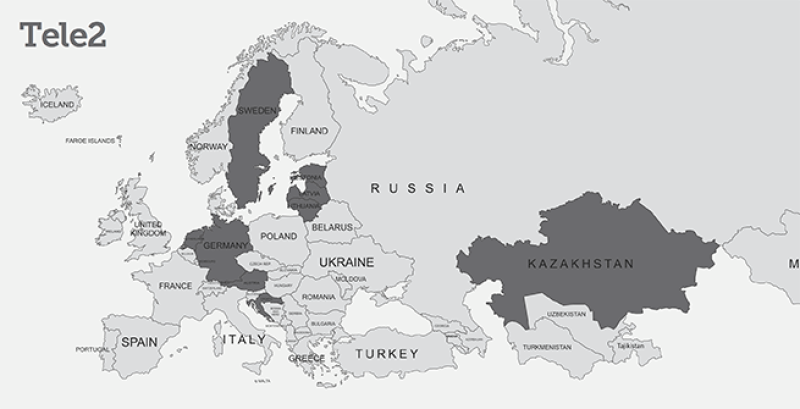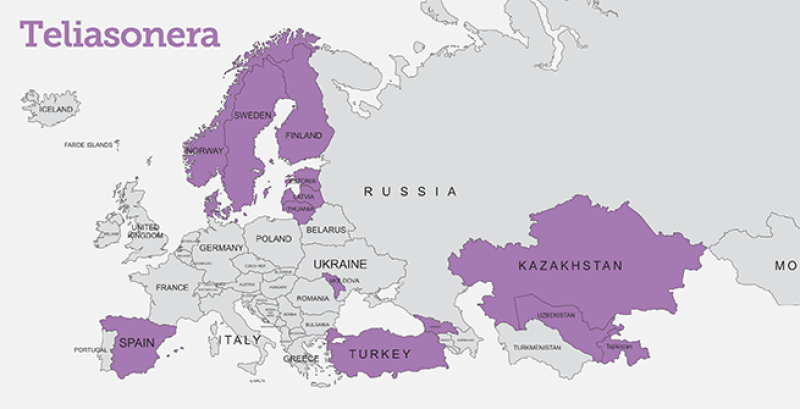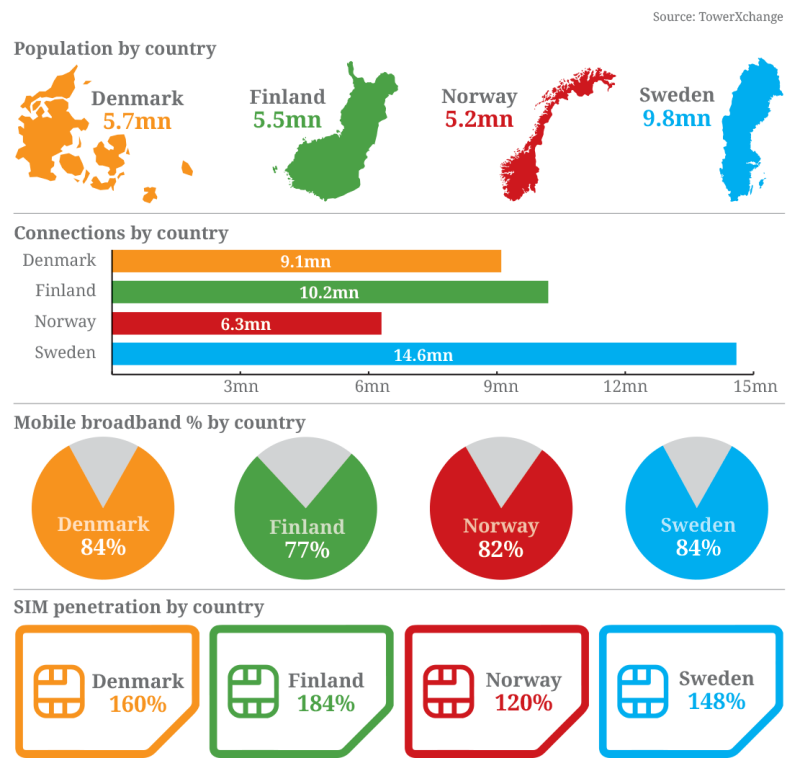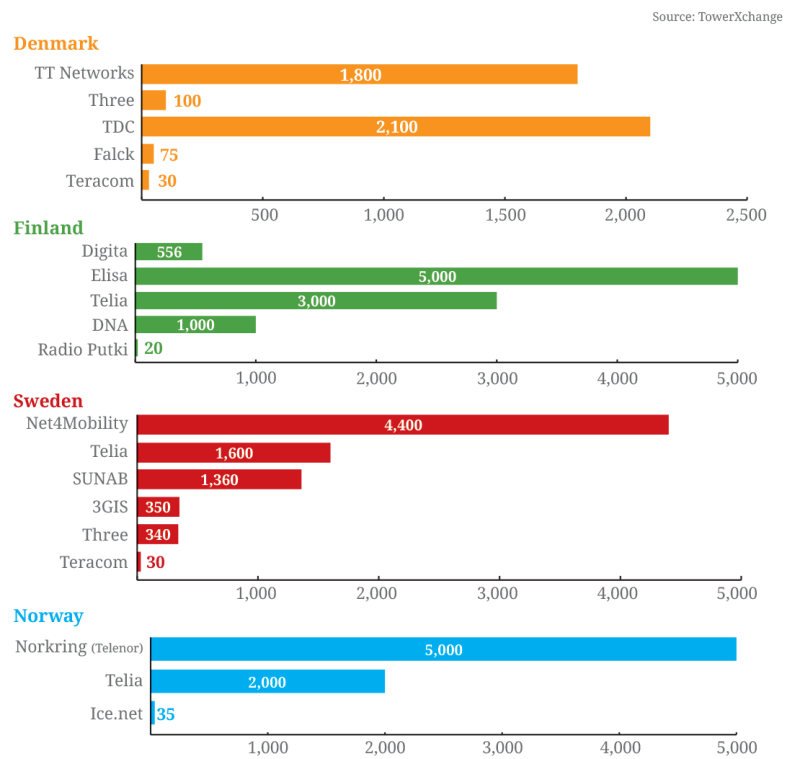Thus far, Scandinavia has proven to be a quiet corner of Europe in terms of towerco activity. Digita’s sale by TDF to Colonial First State in 2012 excepted, there have been no transactions in the region and very little independent towerco presence. However, the market could be about to change. Well accustomed to tower sharing and pushing on with the changes needed to support 5G rollout, Scandinavian MNOs are stable, well backed and forward thinking in terms of infrastructure. In this article, TowerXchange shares an overview of the market and explores how the market could change.
Scandinavia overview
Scandinavia, for the purposes of this article Denmark, Norway, Sweden and Finland, are well known globally for being liberal, stable and progressive countries. Ranked by the World Bank between the 22nd (Sweden) and 44th (Finland) largest economies in the world, Scandinavian brands such as Nokia, Ericsson and Teliasonera have achieved global recognition in the telecoms sector.
Telia Company Active in all four of the markets covered by this article, Telia is 37.3% owned by the Swedish state and 3.2% by the Finnish government, with the remainder of the company listed in both Stockholm and Helsinki. Telia Company can trace its roots back to 1853 and is currently present in Azerbaijan, Denmark, Estonia, Finland, Georgia, Kazakhstan, Latvia, Lithuania, Moldova, Norway, Russia, Sweden, Turkey and Uzbekistan. With 23.5mn subscriptions worldwide, the fact Telia is substantially state owned has not prevented it from significant growth and flexibility.
Telenor Present in Norway, Sweden and Denmark, Telenor has also expanded way beyond Scandinavia with a presence in Hungary, Montenegro, Serbia, Bulgaria, Pakistan, Myanmar, Bangladesh, Thailand, Malaysia and India. Telenor also owns 19.7% of Veon (formerly Vimpelcom), which has a presence in 12 further markets across Eurasia, MENA, Russia and Italy (although this shareholding has been reduced significantly following some controversy around VEON’s dealings in the Eurasian market). 54% owned by the Norwegian government, Telenor is one of the biggest mobile network operators in the world.

Three With operations in Australia, Austria, Denmark, Hong Kong, Macau, Indonesia, Ireland, Italy, Sweden, and the United Kingdom, Three is one of the largest mobile network operators in the world. The company was founded in 2002 and is owned by CK Hutchinson Holdings, based out of Hong Kong.

Tele2 Swedish player Tele2 has a presence in Sweden, Latvia, Lithuania, Estonia, Kazakhstan, Croatia, Germany, the Netherlands and Austria, although it was recently announced that the latter has been sold to Hutch for €95mn. 75% of Tele2’s net revenues are generated in Sweden, the Netherlands and Kazakhstan, and they see the emerging markets in CEE as ‘rockets’ which can ensure future growth. The divestment of their Austrian operations, which is neither a ‘core’, nor emerging market does not come as a surprise.

TDC TDC is listed on Nasdaq OMX Copenhagen and is mainly owned by Danish and international institutional investors, Danish retail investors and TDC employees. TDC came into being in 2000, after changing its name from Tele Denmark, and can trace its roots back to the creation of the first telephone exchange in Denmark in 1882. Currently the clear leader in the Danish market, with 39% of subscriptions, TDC has invested heavily in their network and infrastructure over the last few years.

Elisa Although Telenor doesn’t operate directly in the Finnish market, cooperation with Finnish incumbent Elisa gives them a presence in the market. The agreement between the two operators covers the common development, marketing and support for communication solutions giving both companies a stronger offering to companies with operations in multiple nordic companies. Further collaboration with Vodafone gives Elisa a strong proposition for their international clients. Elisa is listed on the Helsinki stock exchange, with the majority of shareholders being Finnish Institutional Investors.
DNA DNA Oyj was founded in 2000 and took on its current form in 2007. Since then the operator has worked hard to grab market share, not just in telecoms but also in constructing a broadcast network to challenge incumbent Digita, and acquiring PlusTV from Swedish operator Teracom AB.
DNA conducted a successful IPO in November 2016 and has ambitious plans for growth in the burgeoning Finnish market.
Ice.net Ice Norway is owned by AINMT Holdings, part of Ukrainian-American billionaire Len Blavatnik’s Access Industries. The operator began by providing mobile broadband and launched voice services in Norway in 2015, using the Network Norway infrastructure and customer base acquired from Tele2 (as part of the latter’s acquisition by Telia in 2014).
Scandinavian markets

Joint ventures
Scandinavia is perhaps uniquely placed in Europe with several joint ventures and cooperations between competing MNOs, in particular in Sweden. One of the reasons for this could be that Scandinavian regulators subscribe to the view that as long as there is full competition between the operators on the retail side of the business, there is no need to restrict the sharing of network infrastructure and spectrum.
The first joint venture was 3G Infrastructure Services (3GIS) in Sweden, which was set up in 2001 to build up a complete organisation responsible for rolling out and operating the shared 3G RAN between Telenor and Three. The following year TeliaSonera and Tele2 set up SUNAB for managing their shared 3G network, although they chose a different operational model for the partnership. SUNAB was given the responsibility for procurement and coordination of the project but the two operator organisations kept responsibility for executing all tasks related to rollout and operations. Sweden was split up into four regions and each operator took responsibility for two regions. The SUNAB model was later used also for Net4Mobility, the JV between Telenor and Tele2 for their shared 2G & 4G network.
In Finland, Yhteis Verkko, The Finnish Shared Network is a joint operation between DNA and Telia Finland which is responsible for developing and maintaining an entirely new, shared mobile network for Northern and Eastern Finland. The new 2G, 3G and 4G networks cover half of Finland’s total geographical area and serve approximately 15% of the population.
In Denmark, TT Networks is a joint venture between Telia and Telenor, operating on similar lines to SUNAB, with TT Networks handling procurement and administrative tasks but operational responsibilities split on a north/south basis between Telia and Telenor.
Mobile network operators

Scandinavia presents a great candidate for the independent tower market - world class MNOs; robust economies; data-hungry populations and a commitment to the coming fibre and 5G requirements which will mean networks must be overhauled and investment is increasing. So why so little independent towerco activity to date - and will there be a change in the status quo soon?
The pragmatic approach to tower sharing in Scandinavia provides at least part of the answer to the first question. Joint venture projects have been ongoing for over 15 years and continue to be put in place today. This both negates the need for a third party to create efficiencies in the tower market, and adds a layer of complication to any proposed process relating to the sale of infrastructure.
However, the depth of these ventures and their scope often means that, while sites are shared, operational complexities still remain an issue for the MNOs. The model followed by SUNAB and Net4Mobility in Sweden and TT Networks in Denmark centralises the most administrative functions such as purchasing and contract management, but leaves the operational relationships and responsibilities firmly on the doorstep of the operator - and what is more, only gives them control over certain geographical regions while relying on their competitor for others.

So where does this leave a potential towerco market entrant?
There are a number of issues facing Scandinavian tower owners which could be solved (or at least improved) by a good third party tower owner. Unpicking the complexities of responsibility for operational activities across shared networks is an important part of this.
Land leases, as elsewhere in Europe, continue to be a bugbear for Scandinavian operators, with many reducing sites in an attempt to limit their exposure to landlord price hikes. In particular, property owners in high footfall areas such as hotels or airports appear to be able to push through inflated ground rents. For Scandinavian MNOs, passing this costly and time-sapping task to the third party would be a huge benefit.
Of course, independent towercos entering markets where tower sharing is already prevalent face a challenge ensuring they can demand commercial market rates from tenants who are used to quid pro quos whilst also maximising revenue where RANsharing is common. In Denmark, at least, the Telecom Industry association, a group of operators has regulated this, calculating a model based on the amount of equipment used, meaning towers can be ‘fully loaded’ with just one tenant using different equpiment, and that as new technologies roll out revenues should increase. This kind of standard is a double edged sword for commercial operators, but does mean that the market is well accustomed to paying a fair price for colocation.
Another catalyst for independent tower owners in Scandinavia is a new form of financing in infrastructure, with Danish bank Nykredit offering an interest rate of 0.5% up to 60% of the value of the asset. Currently available in Denmark, they plan to expand the offer across all of Scandinavia including Finland, which will be a huge galvanising factor for build to suit activity in the coming years.
Tower ownership in Scandinavia

Emergency Services Networks
Scandinavian emergency services networks are a significant client for Nordic tower owners, with Danish operator SINE on around 70% of TDC’s sites in Denmark. Nødnett, the Norwegian public safety network, was completed at the end of 2015. Working across 2,100 sites, the network has both proprietary towers and rents from Telenor, Telia and Norkring. In Sweden, the Rakel network operates from almost 1,800 sites including those of mobile network operators.
Scandinavian public safety networks are some of the most comprehensive in the world, and represent a strong potential tenant for any independent party entering the market, and could become a strong tenant for independent towercos entering the market.
Who will be Scandinavia’s first mover?
Although there are no open processes underway in Scandinavia at the moment, chatter about the market is increasing in the tower industry. A first mover in the Scandinavian market could well become the catalyst for a shift in thinking from Nordic MNOs and there’s no doubt that investors and strategic partners would be keen to enter this profitable market. In the following section, TowerXchange speculate as to where we could see a potential tower transaction in the market.
Telia With an estimated 4,800 towers in the the Nordic region, plus access to another 3,500 as part of joint ventures in Denmark and Finland, a relationship with Telia could propel an independent towerco into a leading position across the region.
Telia has made no secrets of its ambitions to become a leader in the digital future of the Nordic and Baltic regions, investing almost SEK5bn (around €520mn) in fibre rollout already, with capex increasing in 2016. Their plan to streamline their operations, including reducing their presence in Eurasia and selling their 76.6% stake in Spanish operator Yoigo, goes hand in hand with a review of their passive infrastructure. According to CFO Christian Luiga at Telia’s 2016 Capital Market Day: “When it comes to the towers it’s important that we challenge and understand the strategic consequences before we take a decision, and that is the review we are doing.’
As yet we’ve heard no further comment on the outcome of this review, but the divestment of infrastructure is assuredly on the Telia agenda and it will be interesting to see if this progresses further in 2017.
Telia’s joint venture with Telenor in Denmark, TT Networks, may also be worth watching; the appointment of a new CEO in Q1 2017 as well as new contracts to streamline operations could be a precursor to a full carve out and eventual sale of the Danish infrastructure.
Telenor See above for Telenor’s operations in Denmark.
In Norway, the most attractive acquisition target could be the Norkring infrastructure, which provides towers for both broadcast (as Norkring) and Telenor’s mobile operations. In addition they already offer 2,100 towers across the country for colocation, and work with other operators, emergency services and other tenants.
As yet, Telenor hasn’t divested any of their towers, but with a large global footprint and progressive outlook, there’s no doubt that they are as aware as any operator of the potential benefits and pitfalls of independent towercos, and may well be considering their options as the demand for capital investment elsewhere in their portfolio becomes more pressing.
TDC TDC already have a strong tenancy ratio and, as the biggest tower owner in Denmark, generate a decent amount of revenue from colocations. They are rumoured to have considered selling their towers, but with some significant management overhauls in the last five years and ongoing difficulties with ground rents, their would not be the most straightforward portfolio to acquire in the region.
Conclusion
As momentum for third party towercos moves north across Europe, Scandinavia seems a natural progression for many interested parties. The determining factors seem to be complexities in ownership and existing colocations and the appetite of the region’s tower owners to divest, neither of which is a significant barrier to entry if the timing is right.

